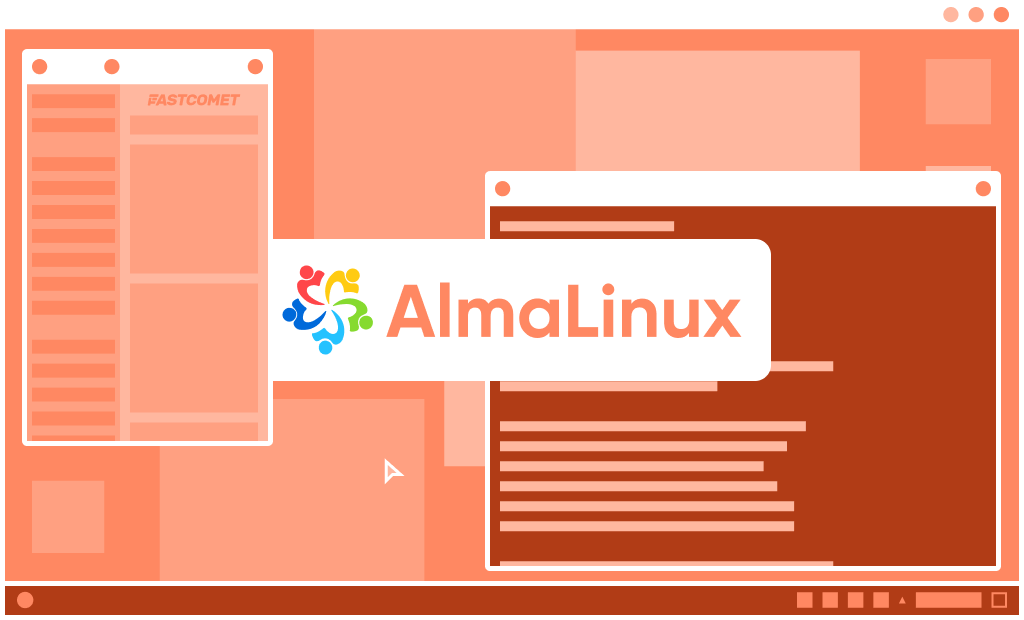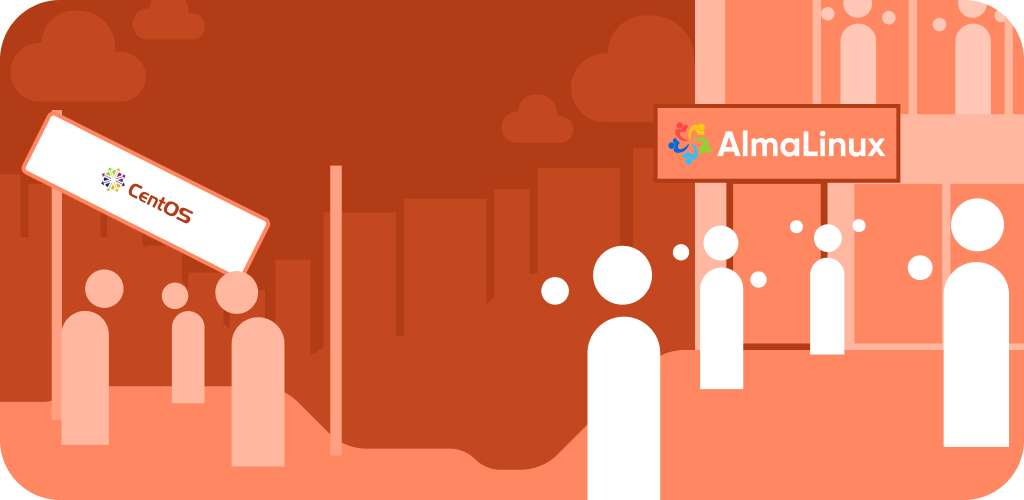
AlmaLinux 9 Now Available at FastComet
Have you heard the slogan “For the community, by the community”? You may have many times, but the specific one we mean is the slogan for AlmaLinux. The free, community-driven Linux distribution has rocketed itself to one of the most serious contenders on the market. You wouldn’t think an open-source distribution like that, managed by a community and free of charge, would be as good as AlmaLinux is, but there it is! That is precisely why we chose it for our services a while back. And that is why we are upgrading it to its latest version: AlmaLinux 9.3 (or just 9, for brevity’s sake).
We are excited to bring you this news because there is more to talk about than just the release notes here. Of course, we will absolutely go over them, but this upgrade also means that we will be using this distribution for a very long time. We will tell you why later as we discuss the new version. Let’s dive right in!

What is AlmaLinux?
Before we look at the newest AlmaLinux update, we should discuss what AlmaLinux is exactly. We suspect that some of our customers may not know what we are talking about.
AlmaLinux is an open-source, community-managed and driven Linux distribution developed by the AlmaLinux Foundation. It was created to answer the controversial CentOS distribution, which was the go-to free and compatible with RHEL binaries distribution at the time. That changed when CentOS made a somewhat contentious move regarding CentOS 8, which came out in 2019. Instead of the expected ten-year live cycle, it was allotted only two, catching a lot of users off-guard. CentOS announced that in 2020, alongside the end-of-support for CentOS in general. The reason for that was the new CentOS Stream, which was no longer free. It left many disappointed and scrabbling to find a solution to their quickly expiring operating system. We wrote a whole blog post about it and our shift away from CentOS.
Attention
We strongly recommend to everyone who still uses CentOS/CloudLinux 6 and 7 to upgrade to AlmaLinux/CloudLinux 9. CentOS/CloudLinux 6 and 7 are outdated systems that no longer receive security updates and therefore have unpatched and exploitable vulnerabilities. By upgrading to AlmaLinux/CloudLinux 9, you get our latest software stack and you stay protected against all types of known vulnerabilities. EOL for the operating systems was on the following dates:
– CentOS 6 EOL: November 30,2020;
– CentOS 7 EOL: June 30, 2024.
Now, why are we telling you all this? Because of that controversy and inconvenience, CloudLinux – whose OS we also use extensively – was inspired to create AlmaLinux. Many consider AlmaLinux to be the spiritual successor of CentOS: free, reliable, and compatible with RHEL binaries.
AlmaLinux Advantages and Features
The fact that AlmaLinux is free likely inspires some doubt in users. After all, how good can a free thing be? It is a relatively new operating system.
It is actually really good. While the AlmaLinux foundation, the OS’s developers, may be non-profit, the project is primarily sponsored by CloudLinux, among others, and development is done with community-first in mind. The slogan is not just for show. As for why you might want to use AlmaLinux for your projects, here are a few advantages and features to help you decide.
- Binary Compatibility – As we mentioned earlier, AlmaLinux is binary-compatible with Red Hat Enterprise Linux. There are two things that this does: it makes the transition from CentOS or RHEL to AlmaLinux distributions very easy. It also allows AlmaLinux to benefit from the vast library of RHEL binaries (YUM or RPM packages, for example);
- Community-driven – The AlmaLinux Foundation’s development process primarily focuses on the community. Collaboration, transparency, and community contributions are the main pillars of the development process. It goes without saying the project has nourished a thriving community, eager to see it flourish and offer support to anyone;
- Free – AlmaLinux is distributed for free and is entirely open-source, which works flawlessly in tandem with the community-driven aspect of the development process;
- Enterprise-level – The operating system has proven itself worthy of the enterprise-level title. Users often view it as the free alternative to the paid Red Hat Linux Enterprise distribution, further proving that AlmaLinux is excellent for large-scale productions;
It is easy to see why AlmaLinux has surged in popularity in the past few years. It filled a niche left barren after CentOS’ move to CentOS Stream. Fortunately for its users, the developers will be supporting for a very long time.
AlmaLinux Life Cycle
The life cycle of an operating system is vital to its security and prosperity. When CentOS cut support for CentOS 8 from ten years to two in favor of focusing resources on CentOS Stream, that absolutely ruined the operating system’s validity and usability. Customers had just switched to it not a year ago. Now they had to switch again or use a system that was about to stop receiving updates.
AlmaLinux, however, has vowed to avoid making the same mistake. Both AlmaLinux 8 and 9 have a long road ahead of them regarding updates and patches. AlmaLinux 8 will have active support until the 31st of May 2024, and security support until the 31st of May 2029. On the other hand, AlmaLinux 9 will receive active support until the 31st of May, 2027, and security support until the 31st of May, 2032. That means AlmaLinux 8 might not get any new features, but the developers will continue to patch security vulnerabilities for years to come.

Why Upgrade to AlmaLinux 9?
Because 9 (9.3 to be precise) is the newest stable version of the distribution! We want the best for our customers. We saw this as a good opportunity to beef up and improve our services. Yes, the previous version will still receive security updates for another half of a decade, but nothing new will be done with it. Third-party developers will move away from it, which can cause compatibility issues. That is enough of a reason for us to implement this upgrade.
AlmaLinux 9 Improvements
The AlmaLinux 9 update itself brought many improvements and additions, but, as we mentioned at the beginning of this blog post, we went ahead and updated our services to 9.3 instead to be on top of everything. That said, here is what the 9 to 9.3 updates brought to the operating system.
| Apache HTTP Server 2.4 | Ruby 3.1 |
| Node.js 18 | PostgreSQL 15 |
| nginx 1.22 | Python 3.11 |
| PHP 8.1 |
| PCP 6.0.5 | Grafana 9.2.10 |
| GDB 10.2 | Dyninst 12.1.0 |
| Valgrind 3.21 | elfutils 0.189 |
| SystemTap 4.9 |
| Apache HTTP Server 2.4.57 | Redis 7 |
| Perl 5.32 | PHP 8.0 |
| Git 2.31 | MariaDB 10.3 |
| Squid 5.2 | Node.js 20 |
| Redis 7 |
| GCC Toolset 13 | LLVM Toolset 16.0.6 |
| Rust Toolset 1.71 | Go Toolset 1.20 |
| GCC 11.3.1 | glibc 2.34 |
| binutils 2.35.2 |
Finally, the new releases brought a ton of security updates, and two new repositories: SAP and SAPHANA. For a full breakdown of the release notes, please visit AlmaLinux’s documentation!
Benefits For You!
All of these updates are excellent, but what do they mean to the everyday user who doesn’t know all those names, modules, components, etc.?
The answer to that question is actually straightforward: better performance, higher security, and increased stability. That is too broad of an answer, though, so let’s expand it! Firstly, AlmaLinux 9 uses kernel version 5.x (version 5.14.0-362.8.1.el9_3 as of 9.3). That means it will be more compatible with modern software and hardware than its predecessor.
Speaking of compatibility, since AlmaLinux 9 is newer, it has a long road ahead of itself when it comes to new features, compatible software, and security fixes. Yes, version 8.x will continue receiving security updates, as we mentioned in the previous section, but no new features will be added. The developers will only patch known or newly found security vulnerabilities. On the other hand, AlmaLinux 9 will see many more years of unknown vulnerabilities being discovered and fixed, as well as new additions to the operating system.
The operating system is what dictates the development of new applications or products. With AlmaLinux 9 out, it is normal for developers to move on to it – as it is the newest one – and cease working with the older version. As you can imagine, developers will create future software versions to work with AlmaLinux 9, which may pose compatibility and security issues for the previous version of the operating system. Newer and stable is typically always better, and we want our customers to benefit from any new developments related to AlmaLinux.
That said, we are already utilizing AlmaLinux 9 on our services. All new VPS and DS servers come with the updated operating system. For servers set up before this update, our customers can purchase an upgrade from the Product section of their Client Area. Simply log in, then go to the Products page and find your VPS or DS. Click on the downward arrow, and select Addons. You will find the AlmaLinux 9 upgrade there. Our professional Technical Support team will carry out the upgrade itself for a seamless transition. If you are unsure what version your server uses or would like to order an upgrade, please contact our 24/7, always-human support team via chat or ticket.
Upgrade Complete
We are happy with AlmaLinux’s newest version and intend to continue updating our services as the operating system progresses. The team behind the software has consistently offered quality and reliability while keeping it free and open-source. That inspires confidence that is less common than one might think in the world of technology. We hope those of you who are involved in the AlmaLinux community will appreciate this move, and the rest will enjoy the peace of mind that the system is here to stay for a very long time.

The latest tips and news from the industry straight to your inbox!
Join 30,000+ subscribers for exclusive access to our monthly newsletter with insider cloud, hosting and WordPress tips!

Comments (2)
How do I upgrade? What is the cost? What method can i use to make payment?
Hello Mark!
In order to upgrade to AlmaLinux 9, please contact our team via Live Chat. They will be happy to answer all of your questions and explain everything.